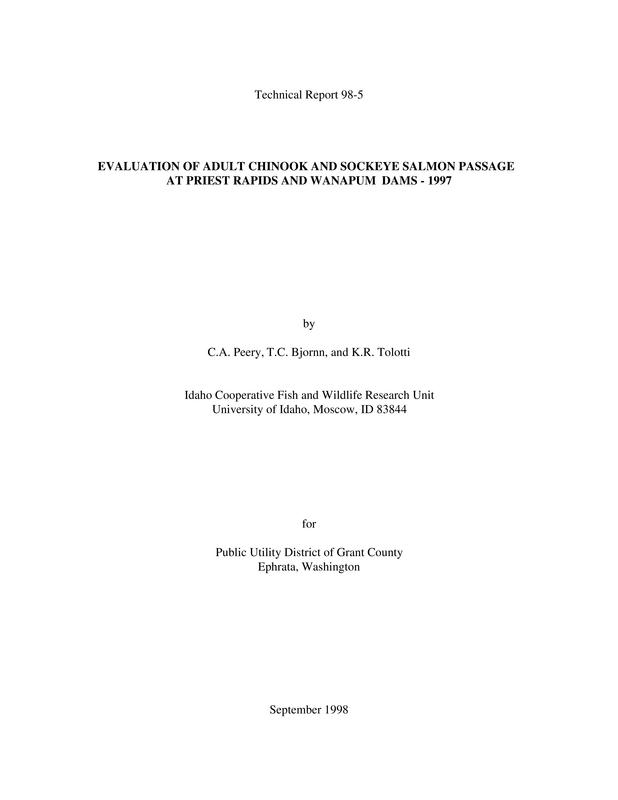PDF
Evaluation Of Adult Chinook And Sockeye Salmon Passage At Priest Rapids And Wanapum Dams - 1997 Item Info
- Title:
- Evaluation Of Adult Chinook And Sockeye Salmon Passage At Priest Rapids And Wanapum Dams - 1997
- Report Type:
- Technical Report
- Date:
- 1998
- Authors:
- Peery, C.A.; Bjornn, T.C.; Tolotti, K.R.
- Affiliations:
- Idaho Cooperative Fish and Wildlife Research Unit
- Report Number:
- 98-5
- Publisher:
- University of Idaho
- Funder:
- Public Utility District of Grant County, Ephrata, Washington
- Abstract:
- Radio-tagged adult spring and summer Chinook salmon Oncorhynchus tshawytscha and sockeye salmon O. nerka were monitored to evaluate passage conditions at Priest Rapids and Wanapum dams, mid-Columbia River, during 1997. Passage conditions were assessed during two treatment conditions: half the powerhouse orifice gates open and all orifice gates closed. Six travel time variables were analyzed using ANOVA analysis and two non-parametric tests. We concluded that closing orifice gates at Priest Rapids and Wanapum dams did not have a significant effect on passage of Chinook and sockeye salmon in 1997. Chinook and sockeye salmon passed through the Hanford Reach section of the Columbia River in 2 to 3 d. Of 217 Chinook salmon that reached Priest Rapids Dam, 199 eventually passed the dam, in 37.6 h, and reached Wanapum Dam. One hundred and ninety Chinook salmon are known to have crossed Wanapum Dam in 20.1 h. Of 440 sockeye salmon that reached Priest Rapids Dam, 427 eventually crossed the dam, in 18.6 h, and reached Wanapum Dam. Four hundred and nine sockeye salmon are known to have crossed Wanapum Dam in 29.7 h. A prototype fishway fence installed inside the west-powerhouse entrance (Lew2) at Priest Rapids Dam was not effective at reducing the number of salmon that exited from the fishway at that point. Salmon were not held up at the fish counting station in the east-shore ladder at Priest Rapids Dam. However, passage times were about three times longer to pass the coded-wire-tag trap near the top of the ladder when the trap was operating as compared to the same section of ladder when the trap was not operating, resulting in median delays 42 min for Chinook salmon and 2.1 h for sockeye salmon. Salmon used the new vertical-slot gate placed at the west-shore fishway entrance (Rew2) as readily as the two other main entrances (Se2 and Se3) at Wanapum Dam. Six (3.0%) Chinook salmon and 16 (3.9%) sockeye salmon fell back at Priest Rapids Dam. Five Chinook salmon and 15 sockeye salmon eventually re-crossed Priest Rapids Dam after an average delay of about 26 h. Eight (4.1%) Chinook salmon and 19 (4.5%) sockeye salmon fell back at Wanapum Dam. Seven Chinook salmon and 12 sockeye salmon eventually re-crossed Wanapum Dam after average delays of about 42 to 48 h.
- Species:
- Chinook salmon, Oncorhynchus tshawytscha sockeye salmon, Oncorhynchus nerka
- Location:
- Columbia River; Priest Rapids Dam; Wanapum Dam
- Subjects:
- salmonids Federal Columbia River Power System FCPRS radiotelemetry migration fishways passage behavior fallback rates
- Source:
- University of Idaho, Fish Ecology Research Lab
- Original Filename:
- 1998-05-CK-SK-passage-at-Priest Rapids-and-Wanapum-1997.pdf
- Format:
- application/pdf
Source
- Preferred Citation:
- "Evaluation Of Adult Chinook And Sockeye Salmon Passage At Priest Rapids And Wanapum Dams - 1997", Adult Salmon and Steelhead Migration Studies: 1996-2014, University of Idaho Library Digital Collections, https://www.lib.uidaho.edu/digital/ferl/items/ferl-tr-98-5.html
Rights
- Rights:
- These files are provided for research purposes with copyright held by the original authors. Please contact the publishing organization for more information about rights.
- Standardized Rights:
- http://rightsstatements.org/vocab/InC-EDU/1.0/

